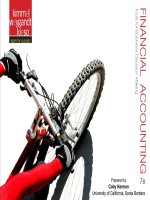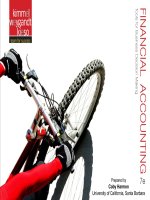Practical financial managment 7e LASHER chapter 15
Bạn đang xem bản rút gọn của tài liệu. Xem và tải ngay bản đầy đủ của tài liệu tại đây (333.06 KB, 28 trang )
Chapter 15 Dividends
Background
Dividends as a Basis for Value
– Dividends are important in determining stock value
Individual investors buy stocks expecting dividends and price
appreciation
»
Dn
Pn
D1
D2
P0 =
+
+ ... +
+
2
n
(1 + k ) (1 + k )
(1 + k ) (1 + k ) n
– From the whole market view, today’s stock price is the present
value of an infinite stream of dividends
Focus on the individual view
Understanding the Dividend Decision
The Discretionary Nature of Dividends
– Board of Directors determines the dividend
Can be more than earnings or nothing
The Dividend Decision
– Whether to pay cash dividends or retain earnings for
growth
Current income
Deferred income
3
The Dividend Controversy
Does paying or not paying dividends affect stock
price?
Do stockholders prefer current or deferred income?
Three arguments regarding investors’ preferences for
or against dividends
1. Dividend Irrelevance
2. Dividend Preference
3. Dividend Aversion
4
Dividend Irrelevance
Most theorists say dividends matter very little to stock price
– Value of eliminated early dividends is offset by growthcreated value in the future
Dn
Pn
D1
D2
P0 =
+
+ ... +
+
2
n
(1 + k ) (1 + k )
(1 + k )
(1 + k ) n
– In valuation equation loss of D1, D2 …. is made up by
gains in later Di (i = 1, 2,…n) and Pn
Concept Connection Example 15-3
Tailoring the Income Stream
The Winters are retirees with most of their savings
invested in 10,000 shares of Ajax Corporation
(AJAX). AJAX sells for $10 per share and pays an
annual dividend of $0.50 per share.
This year AJAX eliminated the dividend, but began
to grow at 5% a year due to the reinvested earnings.
How can the Winters maintain their income and
their position in AJAX?
6
Concept Connection Example 15-3
Tailoring the Income Stream
Original value of the Winters’ AJAX shares
$10 × 10,000 shares = $100,000.
Eliminated dividend
10,000 shares × $0.50 = $5,000.
After one year of 5% growth, AJAX should sell for
$10 × 1.05 = $10.50.
To maintain their income the Winters must sell
$5,000 ÷ $10.50 = 476 shares
After which they would have
10,000 – 476 = 9,524 shares
Worth $10.50 x 9,524 = $100,002.
Dividend Irrelevance
Transaction costs
– The more significant the transactions costs, the less valid
the irrelevance theory becomes
Income taxes
– Dividends are taxed as ordinary income
– Appreciation is taxed as a capital gain
The View from Within the Company
– Dividends represent a cash outflow
– Firms prefer not paying dividends if it avoids selling new
stock
8
Dividend Preference
Investors prefer immediate cash to
uncertain future benefits
– Poor management may waste the funds
rather than using effectively for growth
Inconsistency in theory:
– If investors are worried about management
not using resources effectively, why did they
invest in the firm in the first place?
9
Dividend Aversion
Investors prefer future capital gains to current
dividends because of tax rates
– Price appreciation taxed as capital gain
– Dividends taxed as ordinary income
Argument hinges on current tax rates on dividend
income vs. capital gains income
– Capital gains taxes are not paid until stock is sold
so taxes are deferred
10
Other Theories and Ideas
The Clientele Effect
– Investors choose stocks for dividend policy so any change in
payments policy is disruptive
The Residual Dividend Theory
– Dividends are paid from earnings only after viable projects are
funded
The Signaling Effect of Dividends
– Cash dividends signal management’s confidence
The Expectations Theory
– A refinement of the signaling effect
– Dividends that fail to fulfill stockholders’ expectations send a
negative message even if the payment is good
11
Legal and Contractual Restrictions
on Dividends
Legal Restrictions
Contractual Restrictions
Dividends can’t be paid
out of contributed
capital – must come
from retained earnings
Loan indentures and
covenants may limit
dividend payments to
protect creditors’ interests
Insolvent firms can’t
pay dividends
Cumulative feature of
preferred stock limits
dividend payments
12
Dividend Policy
Dividend policy: Rationale for determining dividend payouts
Payout ratio
– States dividends as a fraction of earnings
payout ratio =
dividend dividend per share
=
earnings
EPS
Stability
– The constancy of dividends over time
– A stable dividend is non-decreasing
– A dividend with a stable growth rate increases at a fairly constant growth rate
Alternate Policies
Target Payout Ratio
– Firm selects a long-run target payout ratio
Stable Dividends Per Share
– A constant dividend is paid regardless of earnings
Small Regular Dividend with a Year-End Extra if
Earnings Permit
– An effort to avoid the signaling effect
14
The Mechanics of Dividend Payments
Each quarterly dividend has key dates:
– Declaration Date: Date the board authorizes the
dividend
– Date of Record: Date by which you must be an
owner to receive the dividend
– Payment Date: Date on which the dividend will
actually be paid – check in the mail
– Ex-Dividend Date: Date from which new stock
buyers no longer receive the dividend
15
Figure 15.1 The Dividend Declaration
and Payment Process
16
Dividend Reinvestment Plans
Large companies offer automatic dividend
reinvestment plans (DRIPs) to stockholders
– Instead of receiving cash dividends, the stockholder
receives additional shares
– The payment is taxable
– Don’t confuse with stock dividend
17
Stock Splits and Dividends
Stock Split
– Stockholders issued
new shares in
proportion to current
holdings
– No change in
proportionate
ownership of company
– Reverse splits also
possible
Stock Dividend
– Similar to stock split
– Called a stock
dividend if the number
of new shares is less
than or equal to 20%
of previously
outstanding shares
18
Rationale for Stock Splits and
Stock Dividends
Stock Split
Trading Range Argument
for splits
– Splits keep stock prices
in a trading range:
accessible to small
investors
Stock usually split when
prices are increasing
– May give false
impression that price
increase is from split
Stock Dividend
Giving Something that
Doesn’t Cost Anything
– Stock dividends are an
attempt at signaling
– Employed to send a
positive message
– Doesn’t really give
shareholders anything
Effect On Price And Value
Splits and stock dividends increase
shares outstanding without changing
economic value of the underlying
company
– Have no real economic effect
20
Accounting for a Stock Split
Accounting for a Stock Dividend
Stock Repurchases
Alternative to Dividend
– Firms with cash on hand can pay dividends
or repurchase their own stock
Repurchase reduces the number of shares
outstanding and increases EPS
Remaining shares will increase in value if the
market maintains the P/E ratio after the
repurchase
23
Concept Connection Example 15-6
Stock Repurchases
The Johnson Company has 2,500,000 shares of common stock
outstanding, net income of $5 million, and a P/E ratio of 10.
EPS = $5,000,000 / 2,500,000 = $2.00 per share;
Market price = $2.00 x 10 = $20.
Johnson has $1 million in cash to distribute to stockholders.
Per share dividend
$1,000,000 / 2,500,000 = $0.40 per share
If Johnson repurchases shares instead it will retire
$1,000,000 / $20 = 50,000 shares
leaving 2,450,000 shares outstanding
24
Stock Repurchases
The new EPS will be
$5,000,000 / 2,450,000 = $2.04 per share.
If the P/E ratio remains unchanged, the stock price
will be
$2.04 x 10 = $20.40
A price appreciation equal to the dividend
25









